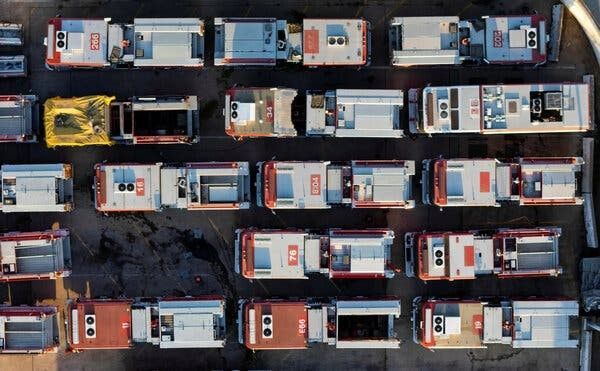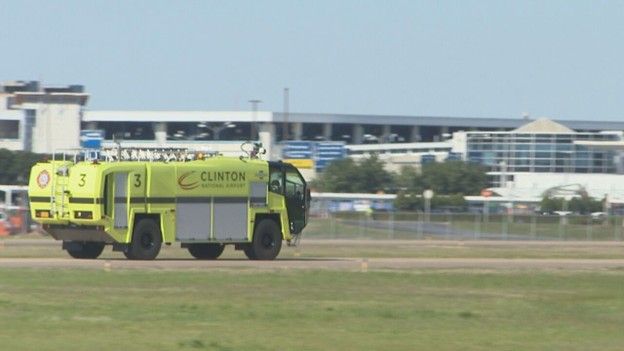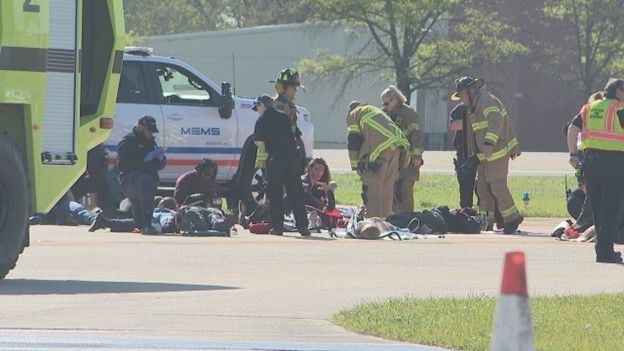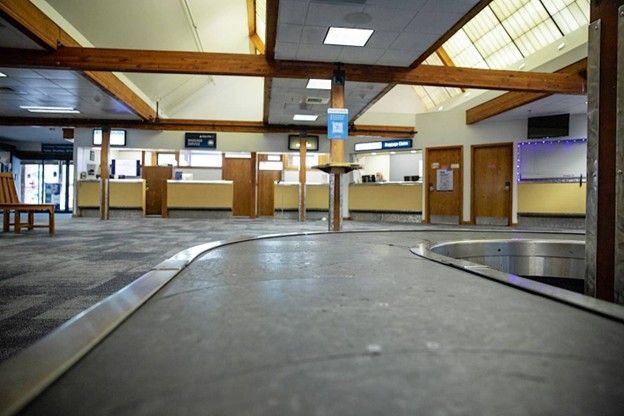ARFF Daily News
Published on:
Wednesday the 16th of April, 2025
Here are your stories for today...
Of note, the story of the US Senate opening a bipartisan investigation into the harms of private equity roll-ups of fire truck manufacturers.
Be safe out there!
Tom
Senators Investigate Private Equity Role in Soaring Fire-Truck Costs
Fire departments say prices for new engines have soared and orders are backlogged for years. Two senators are investigating whether investors who have disrupted the industry are the reason.
By Mike Baker
As fire departments around the country report soaring prices and waiting times for new fire engines, two United States Senators are investigating the effect on public safety and the role that private equity investment has played in disrupting the firefighting equipment industry.
The senators — Elizabeth Warren, Democrat of Massachusetts, and Jim Banks, Republican of Indiana — reported on Tuesday that they had heard from dozens of fire departments about delayed deliveries, defective parts and escalating prices. In a letter to the International Association of Fire Fighters, they said they were concerned that “private equity is padding shareholders’ wallets at the expense of public safety” and that they were seeking to learn more about the situation.
Over the past two decades, the private equity firm American Industrial Partners has acquired a number of specialty vehicle companies, including fire truck manufacturers, and has combined them into a single company called Rev Group. Company executives told analysts that they would substantially raise profit margins and that other companies were doing the same. Rev Group closed two manufacturing plants to streamline its operations.
The New York Times reported earlier this year that prices for fire trucks have soared in recent years and that manufacturers are taking longer to deliver vehicles. Rev Group has said it has a backlog of $4 billion in orders.
Industry leaders have said that the delays and rising prices stemmed from disruptions brought on by the coronavirus pandemic, but some fire officials have blamed the problems at least partly on the industry’s consolidation.
Sue Finkam, the mayor of Carmel, Ind., said she raised the issue with Mr. Banks after she saw how quickly prices for new trucks were rising and how long they would take to be delivered. The estimated price of a new pumper vehicle rose about 10 percent in 2024 from the previous year, she said, while the wait time for a new tiller apparatus is now more than four years.
Ms. Finkam said her city was growing and needed to add more fire stations. But as matters stand now, she said, the city expects to be able to acquire land, design a fire station, construct the building, hire firefighters and train them, while still waiting for the station’s fire engines to be delivered. With the brunt of the pandemic now a few years in the past, she said, she hopes the senators will get answers about the soaring prices and delays.
“The taxpayers are going to be the ones shouldering the burden,” she said.
In Los Angeles, even before the wildfires that consumed whole neighborhoods earlier this year, the city fire department was struggling to maintain its aging fleet, and dozens of vehicles were out of service. Union officials said that rising prices for replacement vehicles had forced the department to order fewer new rigs than it had planned.
Ms. Warren said that the senators’ letter to the International Association of Fire Fighters was the first step in their investigation. She wants to encourage a broader congressional inquiry, and hopes that the Trump administration will get involved.
“Ultimately, when we don’t take care of our firefighters, we make it harder for our firefighters to take care of their communities,” Ms. Warren said in an interview.
Basel Musharbash, an antitrust lawyer who has done his own examination of fire truck manufacturing, said the consolidation in the industry had implications for public safety. But he said that similar private-equity roll-ups are reshaping many other sectors of the economy as well.
“What happened here is alarming and should hopefully attract a lot of attention, not just to the plight of fire departments but to the plight of lots of different industries that are dealing with private-equity-led consolidation,” Mr. Musharbash said.
Mike Baker is a national reporter for The Times, based in Seattle.
https://www.nytimes.com/2025/04/15/us/private-equity-fire-trucks-congress-investigation.html?smid=nytcore-android-share

SENATE FIRE APPARATUS INVESTIGATION (The Secret List)
All,
U.S. Senators Elizabeth Warren (D-Mass.) and Jim Banks (R-Ind.) opened a bipartisan investigation into the harms of private equity roll-ups of fire truck manufacturers.
The lawmakers wrote to the International Association of Fire Fighters (IAFF), North America’s largest union of Firefighters, seeking information about the adverse impact of private equity consolidation on Firefighters and communities in Massachusetts, Indiana, and nationwide.
Here is more:
More to follow.
Take Care. Be Careful. Pass It On.
BillyG
The Secret List 4-15-2025-1635 hours

Clinton National Airport hosts tri-annual drill to strengthen emergency response skills
by Kaelin Clay
LITTLE ROCK, Ark. (KATV) — Over 50 emergency responders from the Little Rock Fire Department Aircraft Rescue and Firefighting, Little Rock Fire Department, Little Rock Police Department, Pulaski County Sheriff's Office, Metroplan Emergency Medical Services, and other agencies joined forces at the Clinton National Airport Tuesday morning to take part in a full-scale disaster exercise.
The drill kicked off at 9 a.m. with live-fire elements and dedicated volunteers acting out the roles of injured crash victims.
Emergency responders took the simulation as an opportunity to practice and strengthen their response. With a different prompt each time, this event takes place every three years to meet Federal Aviation Administration guidelines.
280 plane crashes in the United States have already been reported in 2025, 51 of those fatal.
“We want to learn from every single accident that happens," Shane Carter, Director of Public Affairs and Governmental Relations for Clinton National Airport, says. "In a real emergency, it’s a very fluid situation and we have to make sure that everyone that’s here is ready for any type of emergency that can happen.”
The airport's recent inspection resulted in no discrepancies.
https://katv.com/news/local/clinton-national-airport-hosts-tri-annual-drill-to-strengthen-emergency-response-skills-fire-elements-dedicated-volunteers-plane-crashes-fatal


Aspen Airport Shut Down Over Misidentified Hairdryer
Hundreds of people evacuated the terminal and several flights were delayed.
Mark Phelps
A “security incident” at Colorado’s Aspen-Pitkin County Airport (KASE) that caused an evacuation of the terminal building and caused multiple flight delays on Sunday (April 13) was ultimately traced to a “modified hairdryer” detected by security scanners in a checked bag. According to a report in Aspen Daily News, Transportation Security Administration spokesperson Lorie Dankers said the airport’s computer tomography (CT) scanner’s algorithm was triggered by a hairdryer that was “heavily modified with tape.”
She added, “If something looks suspicious on screen and they’re not able to resolve it, and our explosive specialist was not able to resolve that without getting better visibility on it—and these are people who are highly trained in their position—we have to use and trust their expertise. And that’s what happened here.”
Four deputies from the Pitkin County Sheriff’s Office responded to the call just before noon local time on Sunday. They were able to identify and interview the owner of the bag. “Once we felt comfortable with who they were,” a sheriff’s spokesman said, “then we could start to look at the bag itself.” The Sheriff’s Office said the passenger had done “nothing wrong” and, in fact, had arrived from another airport where the suspicious hairdryer went undetected. The evacuation and flight delays kept the airport shut down for about two hours.
https://www.avweb.com/aviation-news/modified-hairdryer-triggers-airport-security-algorithms/?oly_enc_id=3681J3205156A2X

NTSB Prelim: Wild Sky LLC Goat
Weather Conditions Were “Very Gusty” At The Time Of The Accident
Location: Chester, CT Accident Number: ERA25LA145
Date & Time: March 14, 2025, 15:15 Local Registration: N372WS
Aircraft: Wild Sky LLC Goat Injuries: 1 Fatal
Flight Conducted Under: Part 91: General aviation - Personal
On March 14, 2025, about 1515 eastern daylight time, an experimental amateur-built Wild Sky Goat light-sport aircraft, N372WS, was substantially damaged when it was involved in an accident near Chester, Connecticut. The commercial pilot sustained fatal injuries. The flight was operated as a Title 14 Code of Federal Regulations Part 91 personal flight.
A witness at the airport reported that weather conditions were “very gusty” at the time of the accident. The witness observed the pilot attempt a landing before initiating a go-around. As the aircraft climbed above the treetops, it collided with a tree and descended below the tree line.
Federal Aviation Administration inspectors responded to the scene and examined the wreckage. The aircraft came to rest on its side at the base of a tree. Substantial damage was noted to the fuselage and sail wing. The wreckage was recovered and retained for further examination.
FMI: www.ntsb.gov

Today in History
53 Years ago today: On 16 April 1972 ATI flight 392, a Fokker F-27 Friendship, crashed following a loss of control near Ardinello di Amaseno, Italy, killing all 18 occupants.
Date: Sunday 16 April 1972
Time: 22:10
Type: Fokker F-27 Friendship 200
Owner/operator: Aero Trasporti Italiani - ATI
Registration: I-ATIP
MSN: 10251
Year of manufacture: 1964
Total airframe hrs: 20461 hours
Cycles: 26490 flights
Fatalities: Fatalities: 18 / Occupants: 18
Other fatalities: 0
Aircraft damage: Destroyed, written off
Category: Accident
Location: near Ardinello di Amaseno - Italy
Phase: En route
Nature: Passenger - Scheduled
Departure airport: Roma-Fiumicino Airport (FCO/LIRF)
Destination airport: Foggia Airport (FOG/LIBF)
Confidence Rating: Information is only available from news, social media or unofficial sources
Narrative:
ATI flight 392, a Fokker F-27 Friendship, crashed following a loss of control near Ardinello di Amaseno, Italy, killing all 18 occupants.
Flight BM392 was a scheduled service from Roma-Fiumicino (FCO) to Foggia (FOG). The flight was cleared for takeoff from runway 16 and takeoff was accomplished at 21:56. Immediately after takeoff the crew contacted the Rome Departure controller. The controller confirmed the en route clearance via Pratica, Latina and Teano. He then instructed the flight crew to contact Pratica di Mare. The crew was not able to contact the air traffic controller at Pratica di Mare. At 22:00 the flight contacted Rome Departure again. They reported leaving FL65 for FL110 and noted their problems of contacting Pratica. They were then instructed to call Rome-Control (Terminal Sector South). At 22:04 flight 392 contacted the Terminal Sector South controller and reported at FL100, estimating Latina at 22:10.
At 22:05 the flight was cleared to climb to FL150, following the specific request of the pilot. The F-27 was also cleared for a direct route to Teano, skipping Latina.
Three minutes later the pilot reported passing FL135 and the crew were instructed to switch frequencies to Teano. Nothing more was heard from the flight. By then the flight entered an area of poor weather with local thunderstorm activity. The aircraft had almost reached FL150 when it suddenly lost 1200 ft of altitude and the airspeed dropped 30 knots. This developed into phugoid oscillations from which the pilots were not able to recover. The airplane entered a descent and struck the ground at 340 knots at an angle of 20 degrees.
PROBABLE CAUSES: "The Commission does not have sufficient evidence to determine the certain or probable cause of the accident. However, based on the information from the flight recorder and all conducted investigations, it reasonably hypothesizes that, shortly after reaching the cruise level FL 150, the aircraft suddenly entered an area characterized by strong turbulence and significant downdrafts, which may have led to or coincided with an event or condition that caused abnormal attitudes of the aircraft and/or significant damage to it, even if not identifiable, primarily affecting the flight control system. Meteorological factors alone are ruled out as being able to directly cause the aircraft's fall. There are also no elements to suggest a contributing cause attributable to pilot error, while there are doubts about the pilots' ability to maintain the necessary psycho-physical capacity to control the aircraft during the critical phase of flight, due to the particular stresses they were under."

